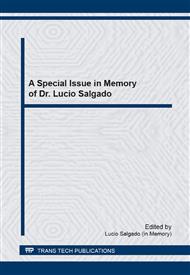p.325
p.331
p.337
p.343
p.350
p.356
p.362
p.368
p.374
Portland Cement for the Cementing of Oil Wells Developed with the Aid of the Rietveld Refinement Method
Abstract:
The use of the Rietveld refinement method has been highlightened as essential in the characterization of polycrystalline materials. With the aid of this method, combined with the application of the X-ray diffraction, it was possible to develop a type of cement that can temporarily substitute the Portland cement for Oil well. This cement was developed from the mixture of Portland cements commonly found in the market. The cements were passed through various sieves, then characterized by X-ray diffraction, being identified the main phases (C3A, C4AF, C3S and C2S) and quantified by the Rietveld refinement method. With the values obtained in the quantification of the phases, a new cement was made through the method of linear programming. From the results, it was possible to conclude that the developed cement presented a composition (levels of the main phases) that satisfies the requirements of NBR 9831, mainly in relation to the low levels of C3A.
Info:
Periodical:
Pages:
350-355
Citation:
Online since:
September 2014
Price:
Сopyright:
© 2015 Trans Tech Publications Ltd. All Rights Reserved
Share:
Citation:


